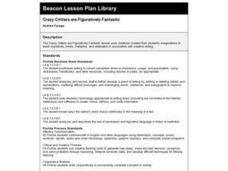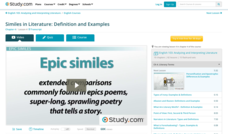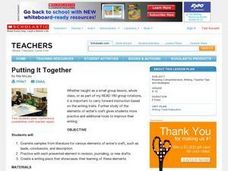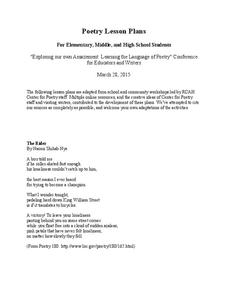Curated OER
Pictures in Words: Poems of Tennyson and Noyes
Students analyze poems by Tennyson and Noyes. They identify examples of alliteration, onomatopoeia, personification, metaphor, and simile. Students create examples of alliteration, onomatopoeia, personification, metaphor, and simile.
Curated OER
Figurative Language in Poetry and Prose
Students examine the impact of sound devices in poetry. In this poetry lesson plan, students read the listed poems and identify uses of hyperbole, simile, metaphor, imagery, and personification. Students discuss how sound devices enhance...
Curated OER
Crazy Critters are Figuratively Fantastic
Eighth graders use creatures created from their imaginations to practice hyperbole, simile, metaphor, and alliteration in association with creative writing. They utilize a worksheet imbedded in this plan to guide their writing.
Curated OER
Poetry: What's on Your Plate (Part 2)
Students write a short paragraph using strong descriptions. In this using modifiers lesson, students define modifier, adjective, adverb, metaphor, and simile. Students then write a journal entry in which they write about a...
Curated OER
I Know Why the Caged Bird Sings
Students use Maya Angelou's novel, I Know Why the Caged Bird Sings to identify themes about adversity in the text. In this adversity, students read chapter 36 of the novel and discuss the examples of adversity in the book. Students...
Curated OER
Stain My Days Blue
Students read several poems related to the life and culture of the Appalachia region. They are introduced to the poetic forms of simile, alliteration and onomatopoeia and respond to the poems through journal entries and poetry of their own.
Curated OER
Emotion Similes
Students define what a simile is before writing a poem that is based primarily on similes. They brainstorm and write the poem using the give format. They write drafts, revise and present a final poem.
Curated OER
Painting Pictures with Poetry
Learners develop their own smilies and metaphors. They examine writing of the Poet Laureate. They identify philanthropy in quotations of others.
Curated OER
Ode to a Nightingale
Students read poems about Tuberculosis by John Keats. Using the poems, they identify similies, metaphors, personification and imagery. In groups, they make connections about the author's outlook on life and how his disease impacted his...
Curated OER
Chalkboard Challenge: Literary Terms
This interactive PowerPoint simulates a "Jeopardy" game that addresses figurative language, cause and effect, and other literary terms. Players can chose which category and amount they would like to play on the Game Board.
Curated OER
"The Story of an Hour" Lesson 3: Teacher's Guide and Notes
The third instructional activity in "The Story of an Hour" series introduces young readers to analogies; a literary device writers use to add depth to their stories. Instructors identify the three analogies in the tale, and class members...
Curated OER
Gift of the Magi LP3
Students read the story of "The Gift of the Magi" and identify the theme and elements in the story. They discuss allusions, situational irony, simile, metaphor, allusion, irony and plot structure. Students share about sacrifices they...
Curated OER
Literary Elements and Grammar Review
Eighth graders review literary elements such as simile, metaphor, allusion, plot sequence, allusion, situational irony, and theme. As the class begins, 8th graders discuss childhood memories. Students write a story about their...
Curated OER
The Gift of the Magi Lesson Plan Two
Ninth graders read, "The Gift of the Magi," discuss the multiple themes of the story and situational irony. Individually, 9th graders review questions from the study guide, explore the simile, metaphor, and allusion. Students prepare...
Curated OER
CAHSEE Literary Terms Word Search Puzzle
In this literary terms word search worksheet, students locate 20 words from a word bank that is located at the bottom of the page. They find words such as metaphor, genre, and simile.
Curated OER
Christmas Poetry
Students explore writing using literary terms. In this Christmas poetry lesson, students write a poem about a Christmas tree or a snowman using at least one example of each: metaphor, simile, and personification.
Curated OER
Short Story 2
Seventh graders review previous reading of Rikki Tikki Tavi. They discuss prior knowledge of simile, metaphor, idiom, and hyperbole. Students practice using vocabulary words from the story by listing synonyms for them. Students read from...
Curated OER
Similes in Literature: Definition and Examples
Be as romantic as a poetic. Appear as clever as Einstein. Wow others with your powers of observation by using similes to point out the similar aspects in two different things. This short video focuses on similes found in Shakespeare and...
Curated OER
Martin Luther King Jr's "I Have A Dream" Speech
Invite your class to investigate racism and civil rights by analyzing the great Dr. Martin Luther King's speech. Your learners will read the words from the "I Have a Dream" speech and analyze the political and racial overtones. They will...
Curated OER
Tell a Ton of Tall Tales
Elementary schoolers read many tall tales. They create their own tall tale about a specific event of their choosing. They must act the part of the author. This well-designed lesson takes three class sessions to complete, and is...
Curated OER
Putting It Together in Writer's Workshop
This lesson plan about writing can be taught in small groups or large group settings. They examine basic writing techniques and practice using them to improve their writing.
Curated OER
Poetry Brainstorm
Looks like? Sounds like? Smells like? Feels like? Tastes like? Sometimes a white, blank, soulless piece of paper can intimidate writers. Provide potential poets with this template that can serve as a parking lot for words and phrases to...
Residential College in the Arts and Humanities
Poetry Lesson Plans
Need some ideas for poetry lessons? Check out this packet loaded with suggestions for elementary, middle, and high school writers.
Curated OER
All About Me from A-Z
Use the letters of the alphabet as prompts for autobiographical poems.

























